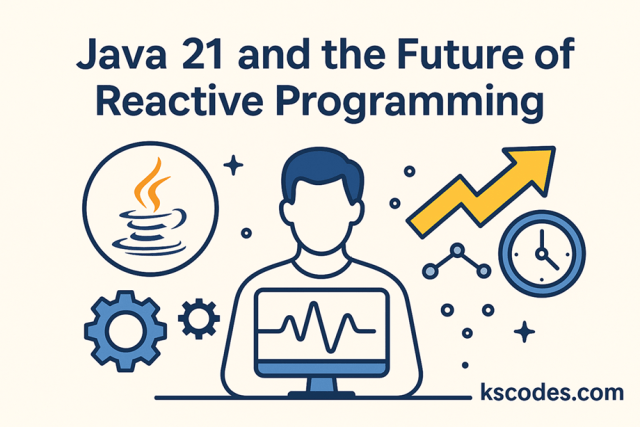🧵 Introduction
Reactive programming has become essential for building scalable, non-blocking, and responsive applications. With Java 21, many new features make writing reactive code easier and more efficient — even if you don’t use complex reactive libraries.
In this post, we’ll explain:
- What reactive programming means (in simple terms),
- Why it’s useful,
- How Java 21 helps,
- Whether you still need libraries like Project Reactor or RxJava,
- And what the future might look like.

🤔 What is Reactive Programming?
Reactive programming is about writing code that reacts to data changes or events asynchronously. Instead of blocking threads while waiting for something to happen (like a file read or database call), you just register callbacks or use streams of events.
|
1 2 3 4 5 6 7 8 |
// Traditional way String data = getDataFromAPI(); // blocks the thread // Reactive way (pseudo-code) getDataFromAPI().onSuccess(data -> { // react to data }); |
Reactive systems are:
- Responsive – they respond quickly.
- Resilient – they handle failures gracefully.
- Elastic – they can scale easily.
- Message-driven – they use async communication.
🧱 Reactive Libraries Before Java 21
Before Java 21, to achieve reactive programming, you usually needed libraries like:
These libraries are powerful but can be hard to learn and maintain — especially for smaller teams or simpler use cases.
🚀 Java 21’s Contribution to Reactive Programming
Java 21 introduces features that reduce the need for complex reactive libraries in many use cases. Let’s explore the key features:
🧵 1. Virtual Threads
Virtual threads are lightweight threads that don’t use up system resources like traditional threads.
✅ Why it matters:
- You can create millions of virtual threads.
- Each thread can wait (block) without hurting performance.
- Easier to write code that looks synchronous but behaves asynchronously.
🔍 Example:
|
1 2 3 4 5 6 |
// With virtual threads in Java 21 Thread.startVirtualThread(() -> { String result = fetchData(); // non-reactive looking code System.out.println(result); // but highly efficient }); |
This allows reactive-like performance with simple, readable code.
🧭 2. Structured Concurrency (Preview)
This feature helps manage multiple tasks (threads) running in parallel, in a safe and easy-to-control way.
🧠 Think of it like:
Managing a team where all tasks must finish or fail together, with clean handling of timeouts and errors.
🧪 Example:
|
1 2 3 4 5 6 7 |
try (var scope = StructuredTaskScope.shutdownOnFailure()) { Future<String> user = scope.fork(() -> fetchUser()); Future<String> order = scope.fork(() -> fetchOrder()); scope.join(); scope.throwIfFailed(); System.out.println(user.result() + order.result()); } |
You don’t need callbacks, reactive chains, or nested subscribe() calls.
🌱 3. Better Integration with Existing Tools
Java 21 plays well with:
- CompletableFutures,
- HTTP Clients,
- JDBC (with some support via virtual threads),
- Executors and thread pools.
This makes it easier to integrate reactive-style execution into existing Java code.
🧠 Reactive vs. Virtual Threads: Do We Still Need Reactive Libraries?
It depends:
| Use Case | Use Reactive Libraries? | Use Java 21 Features? |
|---|---|---|
| Heavy streaming (e.g. Kafka) | ✅ Yes | 👎 Not ideal alone |
| Large-scale REST APIs | ✅/👎 Maybe | ✅ Yes (Virtual Threads) |
| Complex pipelines (e.g. zip, merge) | ✅ Yes | 👎 Not native yet |
| Simple async tasks | 👎 Not required | ✅ Yes |
For simple concurrency and scalability, Java 21 gives you enough out-of-the-box.
🔮 What’s Next for Reactive Java?
Java is evolving toward simplicity with power. Instead of needing 3rd-party tools for everything:
- Virtual Threads simplify concurrency.
- Structured Concurrency offers better task control.
- Future features might bring data streams, reactive pipelines, and better observability.
We may see a hybrid approach: use Java 21 core features where possible, and mix in lightweight reactive libraries only when needed.
✅ Final Thoughts
Java 21 brings reactive-like power to everyone, even beginners. You can now write simple, blocking-style code that performs like async code — without the headaches of reactive complexity.
For many use cases, Java 21 = Simpler Code + Reactive Performance.
If you’re building high-performance APIs, microservices, or scalable apps, Java 21 is a smart step forward into the future of reactive programming.